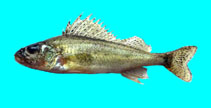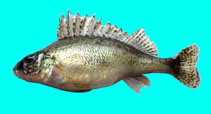Gymnocephalus cernua (Linnaeus, 1758)
Ruffe
Poland country information
Common names:
Jazgarz
Occurrence: native
Salinity: freshwater
Abundance: common (usually seen) | Ref: Winkler, H.M., K. Skora, R. Repecka, M. Ploks, A. Neelov, L. Urho, A. Gushin and H. Jespersen, 2000
Importance: | Ref:
Aquaculture: | Ref:
Regulations: | Ref:
Uses: no uses
Comments: Important food fish in early-mediaeval times (Ref. 52270 ).
National Checklist:
Country Information: https://www.cia.gov/library/publications/resources/the-world-factbook/geos/pl.html
National Fisheries Authority:
Occurrences: Occurrences Point map
Main Ref: Muus, B.J. and P. Dahlström, 1968
National Database:
Occurrence: native
Salinity: freshwater
Abundance: common (usually seen) | Ref: Winkler, H.M., K. Skora, R. Repecka, M. Ploks, A. Neelov, L. Urho, A. Gushin and H. Jespersen, 2000
Importance: | Ref:
Aquaculture: | Ref:
Regulations: | Ref:
Uses: no uses
Comments: Important food fish in early-mediaeval times (Ref. 52270 ).
National Checklist:
Country Information: https://www.cia.gov/library/publications/resources/the-world-factbook/geos/pl.html
National Fisheries Authority:
Occurrences: Occurrences Point map
Main Ref: Muus, B.J. and P. Dahlström, 1968
National Database:
Common names from other countries
分類 / Names 共通名の | 類義語 | Catalog of Fishes(部類, 種) | ITIS | CoL | WoRMS | Cloffa
> Perciformes/Percoidei (Perchs) > Percidae (Perches) > Percinae
Etymology: Gymnocephalus: Greek, gymnos = naked + Greek, kephale = head (Ref. 45335).
More on author: Linnaeus.
Etymology: Gymnocephalus: Greek, gymnos = naked + Greek, kephale = head (Ref. 45335).
More on author: Linnaeus.
Environment: milieu / climate zone / depth range / distribution range 生態学
; 新鮮な水; 汽水性の 底生の漂泳性; pH range: 7.0 - 7.5; dH range: 8 - 12; potamodromous (Ref. 51243); 深さの範囲 2 - 85 m (Ref. 121625). Temperate; 10°C - 20°C (Ref. 13371); 74°N - 43°N, 6°W - 169°E
分布 国々 | 国連食糧農業機関の区域 | エコシステム | 事件 | Point map | 導入 | Faunafri
Europe: Caspian, Black, Baltic and North Sea basins; Great Britain; north to about 69° N in Scandinavia. Asia: Aral Sea basin, Arctic Ocean basin eastward to Kolyma drainage. Several countries report adverse ecological impact after introduction.
Length at first maturity / サイズ / 重さ / 年齢
Maturity: Lm 10.5 range ? - ? cm
Max length : 25.0 cm TL オス/雌雄の選別がない; (Ref. 556); common length : 12.0 cm TL オス/雌雄の選別がない; (Ref. 556); 最大公表体重: 400.00 g (Ref. 556); 最大記録サイズ: 10 年 (Ref. 59043)
Max length : 25.0 cm TL オス/雌雄の選別がない; (Ref. 556); common length : 12.0 cm TL オス/雌雄の選別がない; (Ref. 556); 最大公表体重: 400.00 g (Ref. 556); 最大記録サイズ: 10 年 (Ref. 59043)
簡単な記述 検索表 | 形態学 | 形態計測学
背面の脊椎 (合計) : 11 - 19; 背鰭 (合計) : 11 - 16; 肛門の骨: 2; 臀鰭: 5 - 6; 脊つい: 35 - 36. Distinguished uniquely from its congeners by its body depth 24-27% SL. Differs further from other members of the genus by the combination of having a flank yellowish with numerous, small, irregular, dark blotches and having 11-16 dorsal spines (Ref. 59043). Caudal fin with 16 to 17 rays (Ref. 40476). Dorsal fins are fused. Color brownish with dark spots (Ref. 35388).
Inhabits eutrophic lakes, lowland and piedmont rivers. Most abundant in estuaries
of large rivers, brackish lakes with salinities up to 10-12 ppt and reservoirs. In general, its abundance increases with increased eutrophication (Ref. 59043). Reported to prefer still or slow-flowing water with soft bottom and without vegetation (Ref. 59043) and deep water with deposits of sand and gravel (Ref. 9696). Can tolerate some degradation of the environment (Ref. 30578). Can co-exist in deep lakes with Perca fluviatilis. Both species partly occur at different depths with Gymnocephalus cernua being more abundant in deeper layers (Ref. 59043). The membranous external walls of the head canals of this species provide high directional sensitivity; can feed at night in the dark using the lateral line system; feeds on zooplankton, chironomids, oligochaetes and amphipods (Ref. 10999). Pelagic in coastal lakes and tidal estuaries, preying on zooplankton and fish. Spawns on a variety of substrates at depths of about 3 m or less (Ref. 59043). White to yellow eggs in sticky strands are found on rocks and weed in shallow water (Ref. 41678). Used as bait for pike (Ref. 6258). Females live up to 10 year while males up to 7 years (Ref. 59043).
Life cycle and mating behavior 成熟 | 繁殖 | 放精 | 卵 | 生産力 | 幼生
Eggs turn adhesive on contact with water and stick to stones or plants. Females lay eggs in two or more portions, usually separated by about 30 days in summer. First portion of eggs is larger the second portion. Larvae without or with only a brief, pelagic larval stage, switching early to benthic life, secretive and solitary, not forming schools. Larval survival is poor below 10°C and above 20°C (Ref. 59043).
主な参考文献
Upload your references | 参考文献 | コーディネーター | 協力者
Kottelat, M. and J. Freyhof, 2007. Handbook of European freshwater fishes. Publications Kottelat, Cornol and Freyhof, Berlin. 646 pp. (Ref. 59043)
人間に対する脅威
Potential pest
Human uses
水産業: 少数商業の; ゲームフィッシュ: はい; 餌: usually
FAO(水産業: 代謝; publication : search) | FishSource | 私達の周りの海
より多くの情報
Population dynamics
成長のパラメーター
Max. ages / sizes
Length-weight rel.
Length-length rel.
体長組成
Mass conversion
補充
豊度
成長のパラメーター
Max. ages / sizes
Length-weight rel.
Length-length rel.
体長組成
Mass conversion
補充
豊度
Physiology
Body composition
Nutrients
酸素消費
水泳形態
泳ぐ速さ
Visual pigments
Fish sound
Diseases & Parasites
Toxicity (LC50s)
Body composition
Nutrients
酸素消費
水泳形態
泳ぐ速さ
Visual pigments
Fish sound
Diseases & Parasites
Toxicity (LC50s)
用具
Bio-Quiz | E-book | 野外観察図鑑 | 検索表 | Length-frequency wizard | 生活史の基盤ツール | 目的のマップ | Classification Tree
| Catch-MSY |
特記事項
XMLをダウンロードして下さい
インターネットの情報源
Alien/Invasive Species database | Aquatic Commons | BHL | Cloffa | BOLDSystems | Websites from users | Check FishWatcher | CISTI | Catalog of Fishes(部類, 種) | DiscoverLife | DORIS | ECOTOX | Faunafri | Fishtrace | GenBank(ゲノム, ヌクレオチド) | GloBI | GOBASE | | Google Books | Google Scholar | Google | IGFA World Record | MitoFish | 国のデーターベース | Otolith Atlas of Taiwan Fishes | 公共の水族館 | PubMed | Reef Life Survey | Scirus | SeaLifeBase | 生命の木 | Wikipedia(行く, 検索する) | World Records Freshwater Fishing | 動物に関する記録
Estimates based on models
Phylogenetic diversity index (Ref. 82804): PD50 = 0.5312 [Uniqueness, from 0.5 = low to 2.0 = high].
Bayesian length-weight: a=0.00955 (0.00873 - 0.01045), b=3.00 (2.97 - 3.03), in cm Total Length, based on LWR estimates for this species (Ref. 93245).
栄養段階 (Ref. 69278): 3.3 ±0.57 se; based on food items.
回復力 (Ref. 120179): 手段, 1.4年~4.4年の倍増期間の最小個体群 (K=0.1-0.48; tm=1-2).
Fishing Vulnerability (Ref. 59153): High vulnerability (58 of 100).







